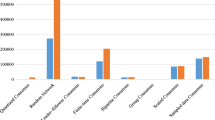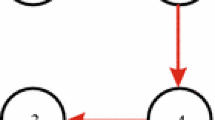Abstract
In this chapter, we investigate the possible advantages of introducing hybrid behaviors in the control of multi-agent systems. With reference to the consensus problem, two complementary settings are explored: hybrid interaction topology and hybrid linear agent dynamics. The results are then applied and further illustrated in synchronization problems for multi-robot systems equipped with heterogeneous sensors with the aim of opening toward new perspectives.
Access this chapter
Tax calculation will be finalised at checkout
Purchases are for personal use only
Similar content being viewed by others
References
Agaev, R., Chebotarev, P.: On the spectra of nonsymmetric Laplacian matrices. Linear Algebra Appl. 399, 157–168 (2005)
Cacace, F., Mattioni, M., Monaco, S., Ricciardi Celsi, L.: Topology-induced containment for general linear systems on weakly connected digraphs. Automatica 131, 109734 (2021)
Caughman, J.S., Veerman, J.J.P.: Kernels of directed graph Laplacians. Electron. J. Comb. 13(1), 39 (2006)
Cristofaro, A., D’Orazio, F., Govoni, L., Mattioni, M.: Application to formation control of a heterogeneous multi-robot system (2023)
Cristofaro, A., Mattioni, M.: Hybrid consensus for multi-agent systems with time-driven jumps. Nonlinear Anal. Hybrid Syst. 43, 101113 (2021)
Cristofaro, A., Mattioni, M.: Multiconsensus control of homogeneous LTI hybrid systems under time-driven jumps. In: 2022 IEEE 61st Conference on Decision and Control (CDC), pp. 316–321. IEEE (2022)
Gambuzza, L.V., Frasca, M.: Distributed control of multiconsensus. IEEE Trans. Autom. Control 66(5), 2032–2044 (2020)
Goebel, R., Sanfelice, R.G., Teel, A.R.: Hybrid Dynamical Systems: Modeling, Stability, and Robustness. Princeton University Press (2012)
Isidori, A.: Lectures in Feedback Design for Multivariable Systems. Springer (2017)
Jadbabaie, A., Lin, J., Morse, A.S.: Coordination of groups of mobile autonomous agents using nearest neighbor rules. IEEE Trans. Autom. Control 48(6), 988–1001 (2003)
Mattioni, M., Monaco, S.: Cluster partitioning of heterogeneous multi-agent systems. Automatica 138, 110136 (2022)
Monaco, S., Ricciardi Celsi, L.: On multi-consensus and almost equitable graph partitions. Automatica 103, pp. 53–61 (2019)
Monshizadeh, N., Zhang, S., Camlibel, M.K.: Disturbance decoupling problem for multi-agent systems: a graph topological approach. Syst. Control Lett. 76, 35–41 (2015)
Nuño, E., Loría, A., Hernández, T., Maghenem, M., Panteley, E.: Distributed consensus-formation of force-controlled nonholonomic robots with time-varying delays. Automatica 120, 109114 (2020)
Panteley, E., Loría, A.: Synchronization and dynamic consensus of heterogeneous networked systems. IEEE Trans. Autom. Control 62(8), 3758–3773 (2017)
Ren, W., Cao, Y.: Distributed Coordination of Multi-agent Networks: Emergent Problems, Models, and Issues. Springer Science & Business Media (2010)
Wang, X., Lu, J.: Collective behaviors through social interactions in bird flocks. IEEE Circuits Syst. Mag. 19(3), 6–22 (2019)
Author information
Authors and Affiliations
Corresponding author
Editor information
Editors and Affiliations
Rights and permissions
Copyright information
© 2024 The Author(s), under exclusive license to Springer Nature Switzerland AG
About this chapter
Cite this chapter
Cristofaro, A., D’Orazio, F., Govoni, L., Mattioni, M. (2024). Multi-consensus Problems in Hybrid Multi-agent Systems. In: Postoyan, R., Frasca, P., Panteley, E., Zaccarian, L. (eds) Hybrid and Networked Dynamical Systems. Lecture Notes in Control and Information Sciences, vol 493. Springer, Cham. https://doi.org/10.1007/978-3-031-49555-7_5
Download citation
DOI: https://doi.org/10.1007/978-3-031-49555-7_5
Published:
Publisher Name: Springer, Cham
Print ISBN: 978-3-031-49554-0
Online ISBN: 978-3-031-49555-7
eBook Packages: EngineeringEngineering (R0)




